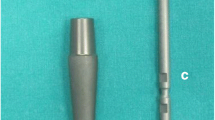Abstract
A total of 113 patients underwent a cemented total hip replacement (THR) operation involving femoral component fixation either without the use of a distal intramedullary plug (n = 57, group 1) or with the plug (n =56, group 2). We studied the femoral component fixation radiographically at on average 6 years after THR. The cement coating was assessed as technically good in 86% and 95% of groups 1 and 2, respectively. There was radiographically diagnosable loosening of the femoral component at the follow-up in 25 cases in which stems were inserted without the intramedullary plug, and in 6 cases in those with the plug (P < 0.0008), and the mean subsidence of the femoral component was 5 mm in group 1 and 1.5 mm (P < 0.0003) in group 2, respectively. Osteolytic changes around the femoral component were noticed in both groups in equal numbers and with no statistical difference. The use of a distal intramedullary plug in the cementation of the femoral stem results in a better cement coating, reduces femoral component subsidence and ameliorates the loosening rates.
Similar content being viewed by others
References
Barrack RL, Mulroy RD Jr, Harris WE (1992) Improved cementing techniques and femoral component loosening in young patients with hip arthroplasty. A 12-year radiographic review. J Bone Joint Surg [Br] 74:385–389
Beckenbaugh RD, Ilstrup DM (1978) Total hip arthroplasty. J Joint Bone Surg [Am] 60:303–313
Eftekhar NS (1987) Long-term results of cemented total hip arthroplasty. Clin Orthop 225:207–217
Gruen TA, McNiece GM, Amstutz HC (1979) “Modes of failure” of cemented stem-type femoral component. A radiographic analysis of loosening. Clin Orthop 141:17–27
Harris WH, McGanna WA (1986) Loosening of the femoral component after use of the medullary-plug cementing technique. J Bone Joint Surg [Am] 68:1064–1066
Herberts P, Ahnfelt L, Malchau H, Strömberg C, Andersson GBJ (1989) Multicenter clinical trials and their value assessing total hip arthroplasty. Clin Orthop 249:48–55
Hierton C, Blomgren G, Lindgren U (1983) Factors associated with early lossening of cemented total hip prosthesis. Acta Orthop Scand 54:168–173
Johanson NA, Bullough PG, Wilson PD, Salvati EA, Ranawat CS (1987) The microscopic anatomy of the bone-cement interface in failed total hip arthroplasties. Clin Orthop 218:123–135
Malchau H, Herberts P, Ahnfelt L, Jonell O (1993) Prognosis of total hip replacement. Scientific exhibition at the 61th annual meeting of AAOS, San Francisco
Paterson M, Fulford P, Denham R (1986) Loosening of the femoral component after total hip replacement. J Bone Joint Surg [Br] 68:392–397
Author information
Authors and Affiliations
Rights and permissions
About this article
Cite this article
Suominen, S., Antti-Poika, I., Tallroth, K. et al. Femoral component fixation with and without intramedullary plug A 6-year follow-up. Arch Orthop Trauma Surg 115, 276–279 (1996). https://doi.org/10.1007/BF00439053
Received:
Issue Date:
DOI: https://doi.org/10.1007/BF00439053




